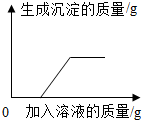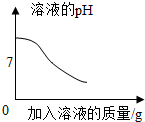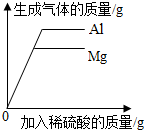问题
多选题
某课外兴趣小组的同学绘制四种实验操作的变化趋势图象,其中正确的是( )
A.

某温度下,向一定量接近饱和的硝酸钾溶液中不断加入硝酸钾晶体
B.

向硫酸和硫酸铜的混合溶液中加入过量的氢氧化钠溶液
C.

向稀盐酸中滴加过量的氢氧化钠溶液
D.

向等质量的金属镁和铝中分别加入足量且质量分数相等的稀硫酸
答案
A、向一定量接近饱和的硝酸钾溶液中不断加入硝酸钾晶体,硝酸钾溶液达到饱和,但因为温度一定,饱和溶液质量分数不变,所以A错误.
B、加入氢氧化钠首先和硫酸反应,没有沉淀产生,当硫酸反应完全后,继续加入氢氧化钠和硫酸铜溶液反应生成蓝色氢氧化铜沉淀,直至全部转换为沉淀保持不变,所以B正确.
C、因为稀盐酸呈酸性,PH<7,图象的起点是大于7,所以C错误.
D、D中是滴加的酸,所以相当于开始酸不足,导致生成氢气的质量取决于酸而不取决于金属,只有一种金属完全反应时,之后曲线才不重叠.因为硫酸足量,所以最终生成氢气的质量由金属决定,根据方程式可知同质量的镁铝,铝生成的氢气的质量大,所以D正确.
故选BD
